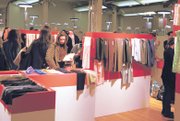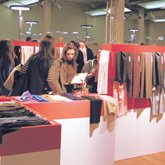Busy Premiegrave;re Vision Preview Draws a Handful of West Coast Names
NEW YORK—Premiegrave;re Vision Preview New York, the abridged version of the last Paris-based textile trade show, had a strong turnout for the Jan. 11–12 run at the Metropolitan Pavilion and Altman Building.
Among exhibitors and attendees, there was a handful of West Coast textile representatives and designers—including Eva Franco, Pegah Anvarian, and representatives from Juicy Couture and American Apparel—according to exhibitors. Other companies shopping the show included Calvin Klein, Eileen Fisher, Jill Stewart, Nine West and Robert Graham.
For Franco, the show’s timing, which coincided with the Intermezzo trade show at New York’s Show Piers, gave her a chance to spend the day at Premiegrave;re Vision Preview after working in her booth at Intermezzo.
Franco said she was still looking for Fall fabrics and for novelties. The designer’s collection is produced in Los Angeles, but Franco sources fabric from around the world, including Europe, China and Turkey. “My fabrics have become more global than ever,” she said, adding that she designs her own prints. Last year, her business doubled, thanks in part to private-label work she does for Anthropologie.
Phil Fox, owner of Los Angeles–based Fox Fabrics, was at the show with two of his collections, Efilan from Italy and Debs Corp. from Japan.
Fox described the mood at the show as “definitely upbeat.”
“There’s a lot more interest across the board in European and Japanese fabrics,” he said.
Kevin Maldonado, co-owner of Studio Bert Forma in Los Angeles and New York, was at the show representing several European collections, including Reynaud Rexo and Philea, both based in France, and button and trim supplier Bottonificio BAP, based in Italy. Pierre Schmitt, director of Philea, was also showing the latest developments from French corduroy and velvet mill Velcrex, which he recently acquired.
Maldonado, who, with his wife, Heather, purchased Studio Bert Forma in 2004, was bullish about the show—and business in general. “It was the best year since we bought the company—by far.”
John Marshall, owner of Los Angeles–based textile agency JM International Group, was at the show with Nicholas Brun, sales manager for French textile mill AB Creations and its Opening collection. Marshall recently opened a New York office, staffed by East Coast Sales Director Brigette Appell, who was also on hand at the show.
Mike Derderian, president of development and sales for the new Los Angeles–based eveningshy;wear and bridal line Atelier Pavoni, was among the designers shopping Premiegrave;re Vision Preview. Derderian launched his company with two other partners after working for Lebanon-based couturier Zuhair Murad. Derderian said it made sense to open in Los Angeles, which has manufacturing facilities as well as access to stylists and celebrity clientele. International affair
Originally, Premiegrave;re Vision—and Premiegrave;re Vision Preview—restricted its exhibitor base to only European mills. But that policy has relaxed over the years, and now show organizers cite the quality of the mills’ products over their provenance.
Indeed, the show features a growing contingent of Korean mills. KOTRA, the Korean trade-development association, has a booth at the show. Other countries with an increasing presence at the show include Turkey and Brazil. (Premiegrave;re Vision organizers anticipate increased participation from Brazilian companies following the Jan. 20–21 debut of Premiegrave;re Brasil, the joint venture partnership between Premiegrave;re Vision and Brazilian Fagga Eventos in Satilde;o Paulo.)
Still, the majority of exhibitors at Premiegrave;re Vision—and Premiegrave;re Vision Preview—are European companies.
Gilbert Heller of New York–based Le Loup Blanc was at the show with French embroideries maker Goutarel, one of Le Loup’s eight collections. “The rest come after PV and work the market,” Heller said.
Christina Knaus of New York–based Grupo Textil was at the show representing French lace collections Sophie Hallette and Riechers Marescot.
“The mood is the best it has been in 2frac12; years,” she said, adding that many companies fared much better in 2010 than they had anticipated. But, she added, her high-end lace collections tend to fare well even in a down market.
“With lace there’s only a couple of people in town—we’re always busy,” she said. “It’s almost recession-proof.”
Sandrine Bernard, vice president for the New York–based arm of French lace mill Solstiss, was at the show with a new collection, French silk maker Denis et Fils. The new collection includes prints, jacquards and novelties.
Bernard said designer and piece-goods buyers began arriving around 10 a.m. on opening day, including large companies, as well as international buyers from Mexico and Guatemala. In addition to bridal and eveningwear designers, Bernard said she saw designers of accessories and shoes.
“So far, so good,” said Peter Vouml;egtlin, who was showing fabrics from German print mill KBC. The turnout, he said, was what he expected for the show. The mood was positive. “We’re seeing the light at the end of the tunnel.”Price-conscious
One of the topics of discussion at the show was the rising price of raw materials—in particular, the escalating cost of cotton.
“Literally, I’ve changed prices in one day,” Franco, the Los Angeles–based designer, said.
KBC’s Vouml;egtlin said that for most companies, “prices have to be, more or less, accepted. It’s been like this already for 12 months.” Although some designers ask for alternatives to cotton, prices for polyester and rayon have also risen, and, Vouml;egtlin said, the ultimate deciding factor is fashion, rather than price. “Fashion does not rely on price alone,” he said.
Indeed, Fox Fabrics’ Fox said he’s seen a change in the market in just a few months. “I’m not getting as much price resistance as I was in October and November,” he said.
But the rising raw-materials prices—as well as other factors, including rising labor costs and increasing demand from China’s domestic market—have led to new uncertainty, said Philippe Pasquet, chief executive officer of Premiegrave;re Vision.
“Compared to the previous year, there are more question marks in the U.S. than in some other markets,” he said. “In that respect, we are at a crossroad. American brands and retailers will have to make a choice about how they position themselves in the future. They seem to be eager to defend their margins. We understand this policy, but in the long-term, there are many risks.”Direction by Indigo
Upstairs from Premiegrave;re Vision was Direction by Indigo, the print show launched by Premiegrave;re Vision in 2009 after the French trade show purchased American print and artwork show Directions in 2008. The show is held annually within Premiegrave;re Vision Preview during the January show.
Unlike the textile collections at Premiegrave;re Vision Preview, at Direction by Indigo, the collections are complete and fully finished, said Gilles Lasbordes, exhibition director for Directions by Indigo.
“It’s not a preview; it’s the first view with the mood of what’s going on in the market,” he said.
Designers and textile buyers crowded the aisles of the show, which took up two floors in the Metropolitan Pavilion.
Missy Pawlecki and Brian Caviness of Orange, Calif.–based Birds of Ohio were at Direction by Indigo for the second year, showing their collection of vintage swatches.
This is the only show the husbandshy;-and-wife team—and Ohio transplants—attend. The two said that in addition to the local designers, they met with designers from Dallas and San Francisco at the show.
“But a lot of people are in a rush to get out because of the snow,” Caviness said.
Indeed, New York was scheduled to get 6 to 12 inches of snow beginning the evening of Jan. 11. Many exhibitors and attendees feared the snow would keep crowds away on the second day of the show (or strand those scheduled to leave on Jan. 12). Those fears turned out to be unfounded, as designers continued to shop on the second day of the show and flights left New York as scheduled throughout the day.























